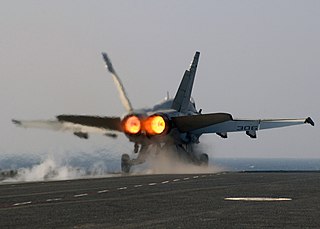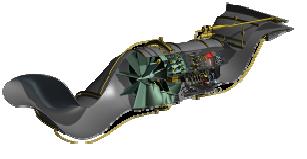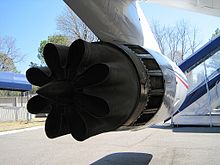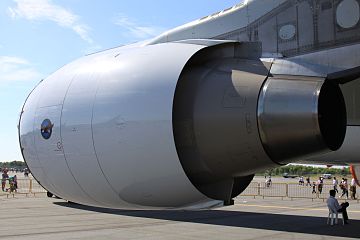
A jet engine is a type of reaction engine, discharging a fast-moving jet of heated gas that generates thrust by jet propulsion. While this broad definition may include rocket, water jet, and hybrid propulsion, the term jet engine typically refers to an internal combustion air-breathing jet engine such as a turbojet, turbofan, ramjet, pulse jet, or scramjet. In general, jet engines are internal combustion engines.
Specific impulse is a measure of how efficiently a reaction mass engine, such as a rocket using propellant or a jet engine using fuel, generates thrust. For engines like cold gas thrusters whose reaction mass is only the fuel they carry, specific impulse is exactly proportional to the effective exhaust gas velocity.

The turbofan or fanjet is a type of airbreathing jet engine that is widely used in aircraft propulsion. The word "turbofan" is a combination of the preceding generation engine technology of the turbojet, and a reference to the additional fan stage added. It consists of a gas turbine engine which achieves mechanical energy from combustion, and a ducted fan that uses the mechanical energy from the gas turbine to force air rearwards. Thus, whereas all the air taken in by a turbojet passes through the combustion chamber and turbines, in a turbofan some of that air bypasses these components. A turbofan thus can be thought of as a turbojet being used to drive a ducted fan, with both of these contributing to the thrust.

The turbojet is an airbreathing jet engine which is typically used in aircraft. It consists of a gas turbine with a propelling nozzle. The gas turbine has an air inlet which includes inlet guide vanes, a compressor, a combustion chamber, and a turbine. The compressed air from the compressor is heated by burning fuel in the combustion chamber and then allowed to expand through the turbine. The turbine exhaust is then expanded in the propelling nozzle where it is accelerated to high speed to provide thrust. Two engineers, Frank Whittle in the United Kingdom and Hans von Ohain in Germany, developed the concept independently into practical engines during the late 1930s.

The Rolls-Royce Trent is a family of high-bypass turbofans produced by Rolls-Royce. It continues the three spool architecture of the RB211 with a maximum thrust ranging from 61,900 to 97,000 lbf . Launched as the RB-211-524L in June 1988, the prototype first ran in August 1990. Its first variant is the Trent 700 introduced on the Airbus A330 in March 1995, then the Trent 800 for the Boeing 777 (1996), the Trent 500 for the A340 (2002), the Trent 900 for the A380 (2007), the Trent 1000 for the Boeing 787 (2011), the Trent XWB for the A350 (2015), and the Trent 7000 for the A330neo (2018). It has also marine and industrial variants like the RR MT30.

The CFM International CFM56 series is a Franco-American family of high-bypass turbofan aircraft engines made by CFM International (CFMI), with a thrust range of 18,500 to 34,000 lbf. CFMI is a 50–50 joint-owned company of Safran Aircraft Engines of France, and GE Aerospace (GE) of the United States. GE produces the high-pressure compressor, combustor, and high-pressure turbine, Safran manufactures the fan, gearbox, exhaust and the low-pressure turbine, and some components are made by Avio of Italy and Honeywell from the US. Both companies have their own final assembly line, GE in Evendale, Ohio, and Safran in Villaroche, France. The engine initially had extremely slow sales but has gone on to become the most used turbofan aircraft engine in the world.

An afterburner is an additional combustion component used on some jet engines, mostly those on military supersonic aircraft. Its purpose is to increase thrust, usually for supersonic flight, takeoff, and combat. The afterburning process injects additional fuel into a combustor in the jet pipe behind the turbine, "reheating" the exhaust gas. Afterburning significantly increases thrust as an alternative to using a bigger engine with its attendant weight penalty, but at the cost of increased fuel consumption which limits its use to short periods. This aircraft application of "reheat" contrasts with the meaning and implementation of "reheat" applicable to gas turbines driving electrical generators and which reduces fuel consumption.

The bypass ratio (BPR) of a turbofan engine is the ratio between the mass flow rate of the bypass stream to the mass flow rate entering the core. A 10:1 bypass ratio, for example, means that 10 kg of air passes through the bypass duct for every 1 kg of air passing through the core.
A propelling nozzle is a nozzle that converts the internal energy of a working gas into propulsive force; it is the nozzle, which forms a jet, that separates a gas turbine, or gas generator, from a jet engine.

The General Electric CF6, US military designations F103 and F138, is a family of high-bypass turbofan engines produced by GE Aviation. Based on the TF39, the first high-power high-bypass jet engine, the CF6 powers a wide variety of civilian airliners. The basic engine core also powers the LM2500 and LM6000 marine and power generation turboshafts. It is gradually being replaced by the newer GEnx family.

The Rolls-Royce Trent 700 is a high-bypass turbofan aircraft engine produced by Rolls-Royce plc to power the Airbus A330. Rolls-Royce was studying a RB211 development for the A330 at its launch in June 1987. It was first selected by Cathay Pacific in April 1989, first ran in summer 1992, was certified in January 1994 and was put into service on 24 March 1995. Keeping the characteristic three-shaft architecture of the RB211, it is the first variant of the Trent family. With its 97.4 in (247 cm) fan for a 5:1 bypass ratio, it produces 300.3 to 316.3 kN of thrust and reaches an overall pressure ratio of 36:1. It competes with the General Electric CF6-80E1 and the PW4000 to power the A330.

The Rolls-Royce Trent 800 is a high-bypass turbofan produced by Rolls-Royce plc, one of the engine options for the early Boeing 777 variants. Launched in September 1991, it first ran in September 1993, was granted EASA certification on 27 January 1995, and entered service in 1996. It reached a 40% market share, ahead of the competing PW4000 and GE90, and the last Trent 800-powered 777 was delivered in 2010. The Trent 800 has the Trent family three shaft architecture, with a 280 cm (110 in) fan. With a 6.4:1 bypass ratio and an overall pressure ratio reaching 40.7:1, it generates up to 413.4 kN of thrust.
A jet engine performs by converting fuel into thrust. How well it performs is an indication of what proportion of its fuel goes to waste. It transfers heat from burning fuel to air passing through the engine. In doing so it produces thrust work when propelling a vehicle but a lot of the fuel is wasted and only appears as heat. Propulsion engineers aim to minimize the degradation of fuel energy into unusable thermal energy. Increased emphasis on performance improvements for commercial airliners came in the 1970s from the rising cost of fuel.

The General Electric YF120, internally designated as GE37, was a variable cycle afterburning turbofan engine designed by General Electric Aircraft Engines in the late 1980s and early 1990s for the United States Air Force's Advanced Tactical Fighter (ATF) program. It was designed to produce maximum thrust in the 35,000 lbf (156 kN) class. Prototype engines were installed in the two competing technology demonstrator aircraft, the Lockheed YF-22 and Northrop YF-23.

A variable cycle engine (VCE), also referred to as adaptive cycle engine (ACE), is an aircraft jet engine that is designed to operate efficiently under mixed flight conditions, such as subsonic, transonic and supersonic.

This article briefly describes the components and systems found in jet engines.
An airbreathing jet engine is a jet engine in which the exhaust gas which supplies jet propulsion is atmospheric air, which is taken in, compressed, heated, and expanded back to atmospheric pressure through a propelling nozzle. Compression may be provided by a gas turbine, as in the original turbojet and newer turbofan, or arise solely from the ram pressure of the vehicle's velocity, as with the ramjet and pulsejet.

The Rolls-Royce Trent 7000 is a high-bypass turbofan engine produced by Rolls-Royce, an iteration of the Trent family powering exclusively the Airbus A330neo. Announced on 14 July 2014, it first ran on 27 November 2015. It made its first flight on 19 October 2017 aboard on the A330neo. It received its EASA type certification on 20 July 2018 as a Trent 1000 variant. It was first delivered on 26 November, and was cleared for ETOPS 330 by 20 December. Compared to the A330's Trent 700, the 68,000–72,000 lbf (300–320 kN) engine doubles the bypass ratio to 10:1 and halves emitted noise. Pressure ratio is increased to 50:1, and it has a 112 in (280 cm) fan and a bleed air system. Fuel consumption is improved by 11%.

The Aurora D8, also known as the D8 Airliner, is an airliner concept under development as of mid 2017. The project was initiated in 2008 by Aurora Flight Sciences, the Massachusetts Institute of Technology (MIT) and Pratt & Whitney under NASA's sponsorship of $2.9 million.

The Boom Symphony is a medium-bypass turbofan engine under development by Boom Technology for use on its Overture supersonic airliner. The engine is designed to produce 35,000 pounds of thrust at takeoff, sustain Overture supercruise at Mach 1.7, and burn sustainable aviation fuel exclusively.



















